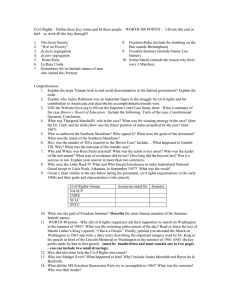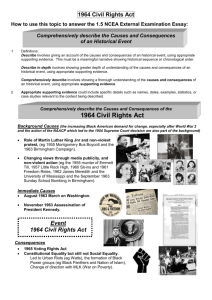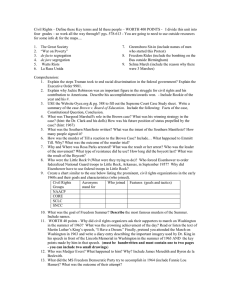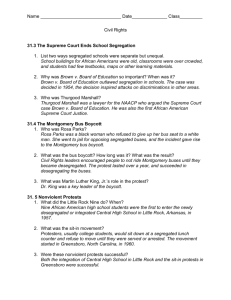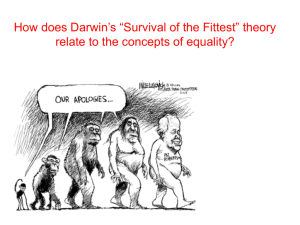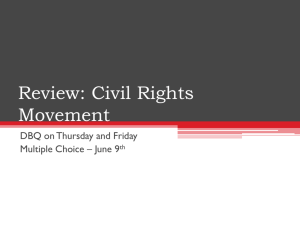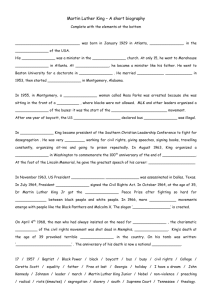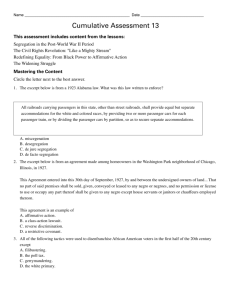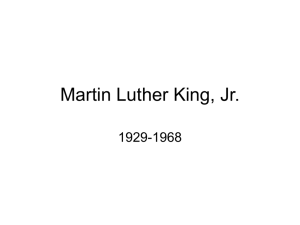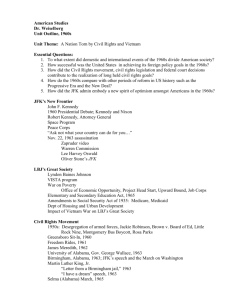The Civil Rights Movement
advertisement
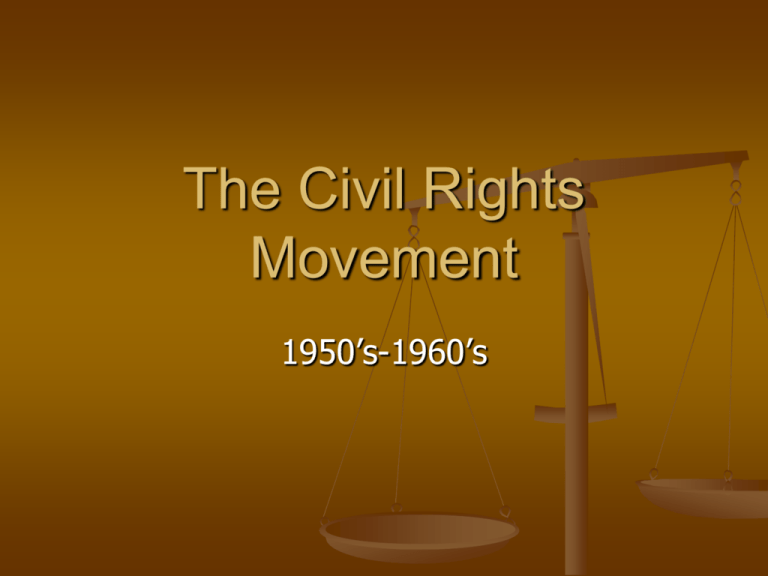
The Civil Rights Movement 1950’s-1960’s Beginnings of Change Until well into the 20th century , much of the South was segregated, or separated by race. Although less apparent in the North, AfricanAmericans were generally restricted to poorer neighborhoods and lower paying jobs. Until the 1950’s gains in Civil Rights were limited. Civil Rights Milestones 1947: Jackie Robinson becomes first African American permitted to play in major league baseball. This was one sign that public attitudes on segregation were beginning to change. Civil Rights Milestones 1948 Executive Order 9981 Truman issues an Executive Order banning segregation in the armed forces. Major Civil Rights Activism & Protests 1954-1965 1954: Brown v. Board of Education Outcome: Supreme Court ruled that separate educational facilities for whites and African Americans are inherently unequal. Overturns 1896 Plessy v. Ferguson decision that separate but equal public facilities were legal 1957 Little Rock Arkansas Arkansas Gov. Orval Rubus uses National Guard to block nine black students from attending a Little Rock High School; following a court order, President Eisenhower sends in federal troops to ensure compliance or that students get into school. Elizabeth Eckford 1 of the 9 African-American students assigned to attend the white Little Rock High after the Brown v. Board decision. 1955:The Montgomery Boycott In Montgomery, Alabama, an African American seamstress named Rosa Parks refused to give up her seat to a white man and move to the back of the bus, as was required by law. She was arrested and her action inspired a boycott of city’s buses. The boycott lasted 381 days. In the end, the Supreme Court ruled that segregation of public buses was illegal. Dr. Martin Luther King Jr. Dr. King emerged as a leader of the bus boycott protests. King had used nonviolent methods of Gandhi & Thoreau or civil disobedience. This means the deliberate breaking of a law to show a belief that the law is unjust. For example, “sit-ins,” boycotts, marches, protests Greensboro: 1960’s Practicing civil disobedience, demonstrators protested segregated lunch counters and buses. Birmingham, Alabama: 1963 It was a KKK stronghold and King described it as America’s worst city for racism. City businessmen actually believed that racism held back the city but their voices were usually quiet. In recent years, the KKK had castrated an African American; pressured the city to ban a book from book stores as it contained pictures of black and white rabbits and wanted black music banned on radio stations. Birmingham Alabama: 1963 In 1963, Dr. Martin Luther King, Jr. and the Southern Christian Leadership Committee began a campaign to bring integration to Birmingham. At this protest march police used dogs and fire hoses to break up the marchers. More than 2,000 people were arrested One of those jailed was Dr. King Television cameras brought the scenes of violence in Birmingham to people across the country which helped build support for the movement. The protests led to the desegregation of city facilities 1963: Birmingham, Alabama The March On Washington: 1963 The growing civil rights movement moved JFK to deliver a televised speech to the nation in June, 1963 on the need to guarantee the civil rights of African Americans. 8 days later he sent the most comprehensive civil rights bill in the nation’s history to Congress. The March on Washington: 1963 Civil rights groups organized a huge march in Washington D.C. in August, 1963. At the march, Dr. Martin Luther King Jr. delivered his famous “I have a dream” speech. March on Washington: 1963 In his speech he expressed his hopes for a unified America. Assassinations April 1968 King went to Memphis, Tennessee to support a sanitation workers’ strike There he was hot and killed by a white assassin. The murder of the leading spokesperson for nonviolence set off new rounds of rioting in American cities. Assassinations Just two months after King’s death, Senator Robert F. Kennedy, brother of the late President and now a presidential candidate committed to civil rights was assassinated. The shock of these deaths and the increasing urban violence made the goals of King & the Kennedy’s seem far off to many Americans. The Civil Rights Act of 1964 Passage of this act came just months after the ratification of the Twenty-Fourth Amendment to the Constitution. 24rth Amendment abolished the poll tax in federal elections that many Southern states had implemented during Reconstruction (1865-1877) Heart of Atlanta Motel v. US: 1964 Racial segregation of private facilities engaged in interstate commerce was found unconstitutional. The Voting Rights Act of 1965 Put an end to literacy tests Authorized federal examiners to register voters in areas suspected of denying African American the right to vote Directed the attorney general of the U.S. to take legal action against states that continued to use poll taxes in state elections. FREEDOM SUMMER! The summer of 1964 was known as this for its many demonstrations, protests, voter registration drives and the March on Washington. Malcolm X: 1960’s Militant Leader for African American rights Attracted those frustrated by the slow pace of the civil rights movement Spoke against integration, instead promoting black nationalism A belief in the separate identity & racial unity of the African American community. Malcolm X: Broke off ties with the separatist group, the Nation of Islam in 1964. Formed his own religious organization: Muslim Mosque, Inc. Pilgrimage to Mecca changed his views on integration and violence. Malcolm X Malcolm X returned and began to work toward a more unified civil rights movement without violence. He made enemies though, and in February 1965, he was assassinated at a NYC rally. RIOTS 1964 & 1965 Frustration over discrimination in housing, education and employment boiled over into riots in NYC, Rochester and the Watts neighborhood in Los Angeles. Affirmative Action: 1960’s This means taking positive steps to eliminate the effects of past discrimination in hiring. Women, African Americans & other minority groups In practice, it often meant giving preference to members of such groups when hiring workers or accepting applicants to schools. Affirmative Action: Issue Reverse Discrimination? 1978 Regents of the University of California v. Bakke imposed limitations on affirmative action to ensure that providing greater opportunities for minorities did not come at the expense of the rights of the majority. In other words, affirmative action was unfair if it lead to reverse discrimination. Johnson & the Civil Rights Act of 1964 LBJ signed this act in July, 1964 It is the most sweeping civil rights law in American history. The bill called for: Protection of voting rights for all Americans Opening of public facilities to people of all races A commission to protect job opportunities for all Americans Considered a turning point in the struggle for civil rights!

